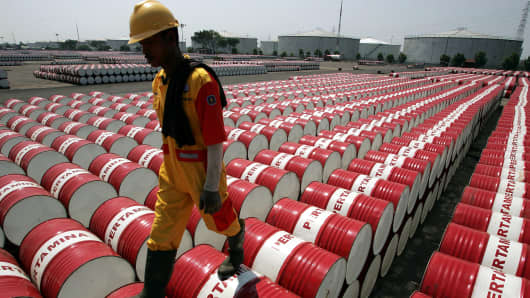
https://www.reuters.com/article/us-global-oil/oil-falls-as-u-s-fuel-stock-build-signals-easing-demand-idUSKBN1E005Q
Oil fell 2 percent on Wednesday after a sharp rise
in U.S. inventories of refined fuel suggested demand may be flagging,
while U.S. crude production hit another weekly record.
Government
data showed that U.S. crude stocks fell 5.6 million barrels, more than
expected, though that was partially the result of the closure of the
Keystone pipeline after a leak in South Dakota in mid-November, which
cut flows to Cushing, Oklahoma. That line reopened Tuesday.
However,
gasoline stocks rose by 6.8 million barrels and distillate inventories
were up 1.7 million barrels, both exceeding expectations in a Reuters
poll.
That hit prices of both crude and products in a market
which is already heavily tilted bullish and thus potentially vulnerable
to a selloff, analysts said.
Gasoline
stocks tend to build in December, but at 221 million barrels of
inventory, stocks are slightly above the five-year average for this time
of year.
U.S. crude production rose to 9.7
million barrels per day, another weekly record, though short of all-time
records reached in the 1970s. That increase may undermine efforts by
global producers to cut supply.
Supply cuts by
the Organization of the Petroleum Exporting Countries, Russia and other
producers that were extended at a meeting last week for the whole of
2018 have helped lift Brent prices by more than 40 percent since June.
Prices have slipped from November’s peak, which represented two-year highs.
“The
sentiment-driven support to crude oil prices has somewhat dissipated as
market participants look beyond last week’s OPEC meeting,” said
Abhishek Kumar, senior energy analyst at Interfax Energy’s Global Gas
Analytics in London.
Brent crude futures LCOc1
were down $1.23, or 2 percent, at $61.63 a barrel by 11:21 a.m. EST
(1621 GMT), after reaching a session high of $62.93, while U.S. crude
futures CLc1 dropped $1.29, or 2.3 percent, to $56.33.
Russian
Oil Minister Alexander Novak said it was too early to talk about
exiting the OPEC agreement, and that the process would be gradual.
Analysts such as Goldman Sachs have said that the expected rise in
demand in 2018 would mostly be offset by U.S. and Canadian supply
growth.
U.S. oil production C-OUT-T-EIA has climbed by 15 percent
since mid-2016 to 9.7 million bpd, close to levels of top producers
Russia and Saudi Arabia.
“With U.S. production, we’re still in
the throes of seeing that go ever higher. There’s only going to be more
production coming which is very problematic for OPEC non-OPEC deal
adherence,” said John Kilduff, partner at Again Capital in New York.
Additional
reporting by Scott DiSavino and Julia Simon in New York; Henning
Gloystein and Keith Wallis in Singapore; Editing by David Evans and
Marguerita Choy
No comments:
Post a Comment